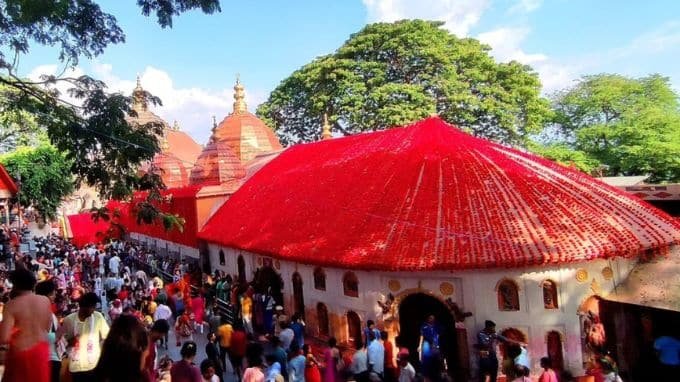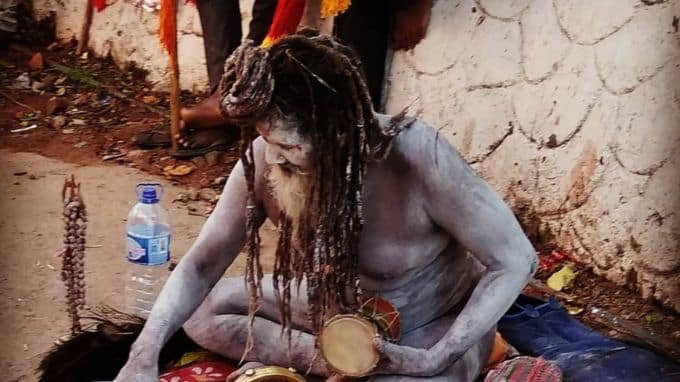The Ambubachi Mela is an annual Hindu religious festival held in the Kamakhya Temple of Guwahati. The festival attracts so many religious devotees during the period that it creates a stampede-like situation. Often termed the ‘Kumbh Mela of Northeast India’, the Ambubachi Mela is unique, exotic and full of ancient customs and rituals. In this blog, we will discuss why Ambubachi Mela is celebrated and its roots in the myths and history of Assam.
About Ambubachi Mela of Assam
The Ambubachi Mela is dedicated to the Goddess Kamakhya, who is considered the embodiment of female power and fertility. The Ambubachi Mela is celebrated during the monsoon season, typically in the month of June. Devotees from various parts of India, especially from the northeastern states, flock to the Kamakhya Temple to participate in the Ambubachi Mela. They observe various rituals and offer prayers to the Goddess. In order to understand why Ambubachi Mela is celebrated, we need to understand the mythological story behind Maa Kamakhya Devi.

Story Behind Maa Kamakhya Devi Temple
The story in bief goes like this: After the death of Devi Sati (wife of Shiva), Lord Shiva full of grief carried the dead body of Devi Sati on his shoulder and roamed the whole universe without having any purpose or destination. To bring back normalcy into the universe, Lord Vishnu with the help of his Spinning Wheel (Sudarshan chakra) made fifty-one parts of Sati’s dead body. The places where the body parts of Sati fell were all turned into holy, religious, places for worshipping her. It is believed that out of the fifty-one body parts, one of them namely the female sexual organ (yoni or vagina) fell above the Nilachal hill of Kamrup and later developed into the Kamakhya Temple.
So, the temple is based basically on yoni-worship, a part of tantric practice that was prevalent in Assam. The tradition has been continued for ages.
Why Ambubachi Mela is Celebrated?
It is believed that during this time, the Goddess Kamakhya undergoes her annual menstrual cycle. It is the manifestation of symbolism of yoni worship or the devotees believe so. Just like any other women, Maa Kamakhya has also her menstrual cycle. However, in her case, it is annual menstruation.
Many ne0-Hindu philosopher reason that this myth was carefully crafted to spread awareness about menstrual cycle among the people and remove various social taboo associated with it.
As the menstruation of the Devi continues for three days. The temple remains closed for three days. These three days are considered to be a time of rest and purification for the Goddess. Even though the temple remains closed for three days for public, secret rituals are performed by temple priests inside the Garbha Griha (Sanctum Sanctorum) of the temple.
After the three days, the temple door is opened for public and Ambubachi Mela officially begins. The road from Kamakhya Gate to Main Temple gate which has distance of about 3 km is closed for vehicles and people start a uphill trek to Mandir once they know that the gate has opened.
What Happens During the Ambubachi Mela?
After the closure of temple, the devotees want to get a first glimpse of the yoni-shaped stone representing the goddess Kamakhya and receive the sacred cloth, Kamakhya Devi Red Cloth or Ambubachi Cloth. It is believed that a white cloth is placed around the sculpture of Yoni during the three day closure. However, after three days the cloth turns red. No one knows the actual reason for it. Legend has it that the blood discharge of the Devi during her periods is reason behind it.
The festival is also marked by various cultural events, religious discourses, and performances. The atmosphere is vibrant and filled with devotion as thousands of pilgrims gather to seek the blessings of the Goddess.

Rituals Observed During Ambubachi Mela
It is believed by Hindus that the Earth, commonly associated as Mother Earth, becomes unclean for 3 days and therefore should be secluded in the same format that some traditionally practicing Hindu women seclude themselves during their own menstrual cycles.
During these 3 days, some restrictions are observed by the Hindu devotees (e.g. cessation of cooking, cessation of performing worship, cessation of reading holy books, cessation of farming etc.). After 3 days, Devi Kamakhya is bathed by cleaning the statue which represents her with red pigment flowing from her vaginal canal, alongside other rituals which are carried out to ensure that the devi retrieves purity.

Why Should You Visit Ambubachi Mela?
It is believed that during this period, the Goddess’s powers are at their peak, and blessings and boons sought during this time are highly auspicious. If you want to get the original Red Cloth or Ambubachi Mela, then you must visit the temple during the Ambubachi Mela. The devotion of these pilgrims is believed to bring rain and fertility back to the Earth.
Kamakhya Prasad During Ambubachi Mela
During Ambubachi Mela, two kinds of special prasads are distributed among the devotees – Angodak and Angabastra. Angodak is the red colored Holy water of Maa Kamakhya Devi believed to be released during the three day menstruation. It is a mixture of holy water and sindoor. Angabastra is the red cloth or ambubachi bastra. These special prasads of Kamakhya temple are hard to get until and unles you have good connections with the temple priests.

















